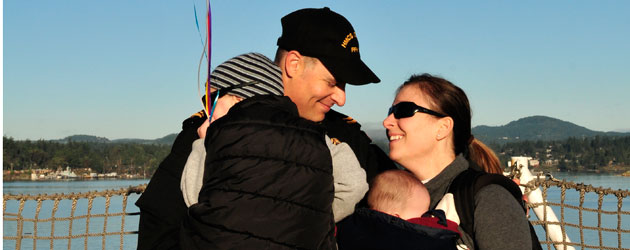
Reunited with family
Lt(N) Darren Follick reuintes with children Tristen and Finnegan and wife Padre Angela James. HMCS Ottawa returned last week from Operation Caribbe off the coast of Costa Rica.

Lt(N) Darren Follick reuintes with children Tristen and Finnegan and wife Padre Angela James. HMCS Ottawa returned last week from Operation Caribbe off the coast of Costa Rica.

[caption id="attachment_3091" align="alignnone" width="300"] Victoria Hyundai will be handing the keys to this car over to one lucky military member on Dec. 18.[/caption] On Dec. 18 one lucky DND member will drive away in a brand new car.The giveaway, which takes place at Victoria Hyundai’s location at 525 Gorge Road East, is the final point in a year-long contest.“It’s exciting. It might sound a little melodramatic but this draw could change a DND member’s life,” says Steve Munro, owner of Victoria Hyundai.In the spirit of efficiency, the four finalists in the car giveaway have been drawn already. That doesn’t mean the drama is over. At the event, each of the four finalists will take a set of car keys from a bowl. Whoever has the key that starts the car will drive away in the 2012 Alantra Touring.“We wanted to make sure that whoever won the car would be there, but that doesn’t mean there won’t still be some excitement to the event,” says Munro.The event begins at 4 p.m. and any member from the DND community is invited to enjoy eggnog, live music and the draw.Those who show up will be entered into a draw for door prizes, which will be drawn by special guest Base Commander Capt(N) Bob Auchterlonie.The idea for the giveaway came when Munro, a retired artilleryman, decided he wanted to do something just for DND members.“The base accounts for about 90 per cent of our business,” says Munro. “We decided it was time to give something back to the military community.”The camouflage-wrapped car has been a constant presence on the base for most of a year, and around 3,500 entry ballots have been collected. Munro says it feels good to have the campaign finally draw to a close.“It let’s us reflect back on the year...

[caption id="attachment_3088" align="alignnone" width="300"] Lynda Lee clips Lt Malory McDonald’s long locks before shaving her head during the Base Logistics Hockey Challenge at Wurtele Arena. Lt McDonald is donating her hair to CanDonate, a Quebec company that makes wigs free of charge for children who lose their hair during cancer treatment.[/caption] At the start of the Government of Canada Workplace Charitable Campaign (GCWCC), Lt Mallory McDonald put forth a challenge to her colleagues at Base Logistics: raise more than $22,000 and she would cut off her long locks. As the fundraising surmounted the goal by $1,500, she knew it was time to hear the snip of the scissors. But with a long mane of hair to lose, she thought of how to make good use of it once it left her scalp. “I figured if I was going to shave it off, it had to be for a good cause,” says Lt McDonald. “I heard of people donating their hair to various organizations and I Googled hair donations in Canada and emailed a handful of them.”She found CanDonate, a non-profit in Quebec that makes wigs free of charge for local children under the age of 16 battling cancer. It takes 12 to 14 pony tails, which must be at least eight inches long, to make a wig, and the donors are encouraged to write letters to the children who will receive them. “I think it’s great that CanDonate is making wigs for these children and I am happy to be a part of it,” she said. Last week she proudly made good on her unit challenge, and a beautiful pony tail is now en route to Quebec. Shelley Lipke, Staff Writer

[caption id="attachment_3085" align="alignnone" width="300"] Members of Fleet Diving Unit (Pacific) ran through the cities of Langford and Colwood to generate donations for the West Shore Christmas Hamper Turkey Run.[/caption] Navy divers have ensured more than 650 families in the West Shore have a turkey, or protein of their choice, on their table this Christmas. It’s the result of 60 military members and 20 spouses and friends taking to the streets Dec. 1 for a six-hour Christmas Hamper Turkey Run.They raised $22,100 for the Goldstream Food Bank; that’s $5,000 more than last year. To add to this feat, some divers wore re-breathers and even the full bomb suit. They used dive boots to collect cash from onlookers and motorists. “People were so generous,” said event organizer Lt(N) Walter Dubeau. “The average donation was about $5 per car and lots of people handed out $20 and we even had $100.” Two interactive displays were set up along the route in front of Mill Stream Village and West Shore Town Centre to spread awareness of what the military divers do, and two hot dog stands helped to raise additional money.“We received outstanding support from West Shore RCMP and Military Police in ensuring the traffic was cleared for our passage the entire day,” said Lt(N) Dubeau.“This event really brings the community together and we are very thankful for the support from local businesses,” he added.The prize for the biggest corporate donor, a deep sea dive helmet to display for a year, went to Original Joes Restaurant and Bar for $4,800. Everything Wine was also a major sponsor of the event. Six Mile Pub hosted a party after the run that included a silent auction. “The highlight was the esprit de corps and camaraderie we had throughout the day. Everybody was smiling and had a...
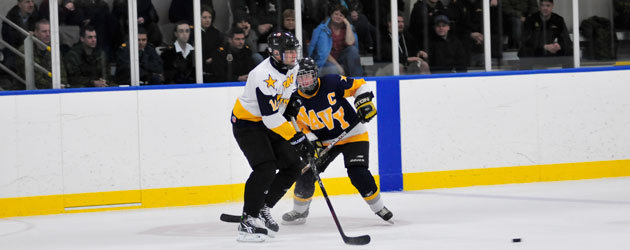
During the MARPAC Hockey Challenge last Thursday members of the Victoria Royals teamed up with MARPAC hockey players and local media in support of the GCWCC-United Way campaign.

Roger D’Amour, Wurtele Arena attendant, holds up his winning entry for the chuck a puck competition during the MARPAC Hockey Challenge to raise money for GCWCC-United Way.
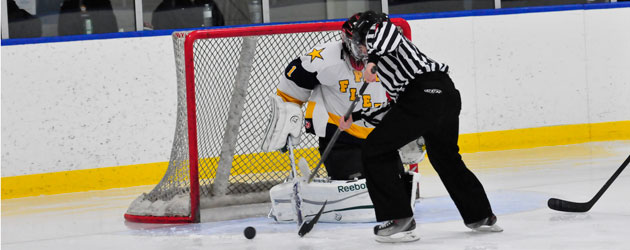
A referee gets in on the action during the MARPAC Hockey Challenge last Thursday during which members of the Victoria Royals teamed up with MARPAC hockey players and local media to raise money for the GCWCC-United Way campaign.
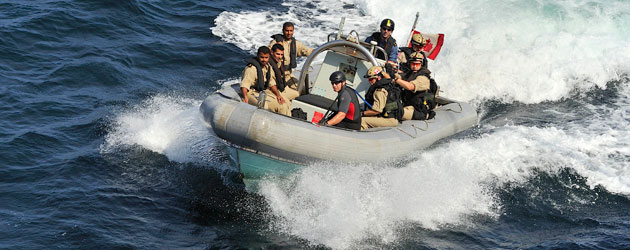
HMCS Regina’s naval boarding party, along with two Yemeni officers, deploy in their rigid hull inflatable boat to approach a fishing vessel in the Red Sea during Operation Artemis.
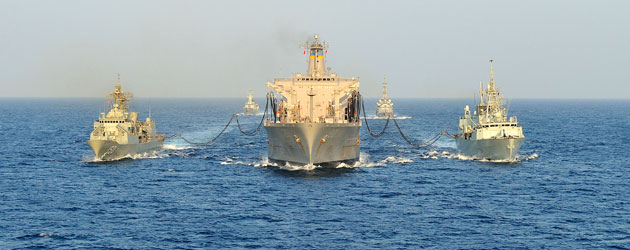
HMCS Regina (right) along with HMAS Anzac (left) conduct a replenishment at sea with USNS Patuxent (centre) in the Gulf of Aden during Operation Artemis.
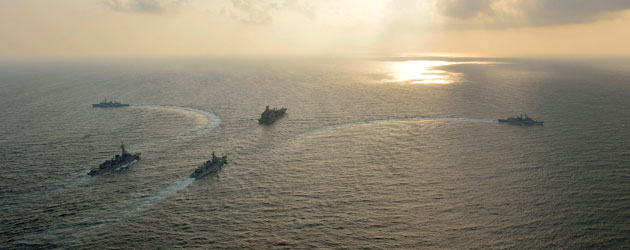
HMCS Regina (far left) and HMAS Anzac (far right) break away from supply ship USNS Patuxent (centre) upon the completion of a replenishment at sea in the Gulf of Aden during Operation Artemis.

[caption id="attachment_3025" align="alignnone" width="300"] HMCS Ottawa’s Sea King helicopter and members of a U.S. Coast Guard boarding party approach a suspect vessel in international waters near Costa Rica.[/caption] Two weeks ago, while patrolling in international waters southeast of Isla de Coco, Costa Rica, HMCS Ottawa assisted a United States Coast Guard Law Enforcement Detachment team in boarding a suspicious fishing vessel. This boarding resulted in the seizure of 36 bales of cocaine weighing 1,086 kilograms, with an estimated wholesale value of more than $29 million USD. Between Nov. 18 and 29, CP-140 Aurora crews from 19 Wing, Comox, and 14 Wing, Greenwood, assisted in seizing, through surveillance and detection, 144 bales of cocaine weighing 4,300 kilograms, with a wholesale value of more than $116 million USD. In total, more than US $145 million worth of drugs were seized.In 2012, in addition to Ottawa, the Canadian Forces contributed five HMC ships to counter-narcotic operations in the Caribbean region. Frigate HMCS St John’s, the destroyer HMCS Iroquois, the replenishment ship HMCS Preserver and two maritime coastal defence vessels, HMCS Kingston and HMCS Goose Bay all deployed to the region this year to assist in the disruption of illicit drug trafficking and other criminal activities. While operating in international waters, their tasks are to locate, track, approach and potentially intercept suspicious vessels in order to allow the U.S. Coast Guard Law Enforcement Detachment personnel to board and conduct law enforcement operations. “The Royal Canadian Navy continues to work alongside our allies and whole-of-government partners to help suppress criminal activity at sea and interrupt the flow of illicit drugs destined for our shores,” said Vice-Admiral Paul Maddison, Commander of the Royal Canadian Navy. “We are taking the fight to the narco-trafficker in their backyard, denying them freedom of movement at sea, enforcing the rule...

[caption id="attachment_3021" align="alignnone" width="300"] Air Force Cpl Rob Stoodley attempts to free entangled sea turtles.[/caption] Last Tuesday, while deployed on Operation Caribbe, Canada’s contribution to the international war on drugs, HMCS Ottawa and its Air Detachment worked seamlessly together in an animal rescue. Ottawa’s Sea King helicopter and crew were conducting patrol ahead of the ship when the aircraft captain, Capt Derek Kauth noticed an unmanned bamboo raft in the water with three sea turtles in tow. At a closer look, the crew found that two of the sea turtles were hopelessly tangled in a net attached to the raft. The crew put their search and rescue training into practice by lowering their Airborne Electronic Sensor Operator, Cpl Rob Stoodley down the rescue hoist into the water to attempt to free the turtle. The aircrew, based out of 443 MH Squadron, provided continuous radio updates to the ship and launched a smoke-marker into the water to indicate the trapped animals’ position. Ottawa quickly closed the helicopter’s position. The ship arrived and deployed its Rigid Hull Inflatable Boat and Zodiac, carrying sailors from the ship’s diving team. PO2 Jason Bode was able to grab a hold of the net with a hook, while MS Allan Kobayashi unhooked the netting from one of the turtles. PO2 Bode and LS Sean Dubeau snipped the netting away from the second turtle allowing the two turtles and a hiding turtle baby to swim away unharmed. The dive team disassembled the bamboo raft altogether and removed the netting from the sea to prevent further wildlife endangerment. The rescue was an impromptu and well-executed effort between all departments of Ottawa and its Air Detachment, speaking volumes to the hard work and continuous training they have conducted during the past several months. The success was a great morale...

[caption id="attachment_3016" align="alignnone" width="300"] HMCS Victoria performs hoisting drills with a Sea King helicopter from 443 Maritime Helicopter Squadron during sea trials.[/caption] The on-going transformation activities within the Royal Canadian Navy have spawned the creation of the Canadian Submarine Force (CSF).The newly formed organization addresses the need for centralized management of submarine forces within the navy. Because the submarine community is relatively small (about the size of a frigate crew), the establishment of the submarine capability on both coasts resulted in significant pressure on a small number of experts. “We ended up spreading ourselves a little thin; perhaps too thin,” says Capt(N) Luc Cassivi, the inaugural Director Canadian Submarine Force. “The Commander RCN agreed that we needed to bring experience and expertise together to ensure we’re supporting submarine operations in a safe and sustainable manner.”As the Director Canadian Submarine Force, Capt(N) Cassivi is the navy’s submarine expert and the main advisor to Commander Royal Canadian Navy (RCN) on all submarine matters. He leads a team of specialists focused on: • coordinating submarine-specific force generation and submarine force employment• planning and execution of east and west coast submarine operations• exercising operational control of all submarines on behalf of the Formation Commanders and the Maritime Component Commander• ensuring the long term health, safety, and sustainability of the submarine force • representing the RCN in all national, NATO, allied, and Asia-Pacific submarine operations related forums It’s expected three of Canada’s four submarines will be available for operations by late 2013. A high-readiness submarine will be available in both the Atlantic and Pacific oceans, and a third submarine will be available for other tasks. As part of the ongoing submarine operational cycle, the fourth submarine will rotate into a scheduled deep-maintenance period. Top on his agenda is to ensure efforts are coordinated to safely...

Corporal Kendall Hartjes operates an Unmanned Aerial Vehicle (UAV) from HMCS Regina while deployed on Operation Artemis.
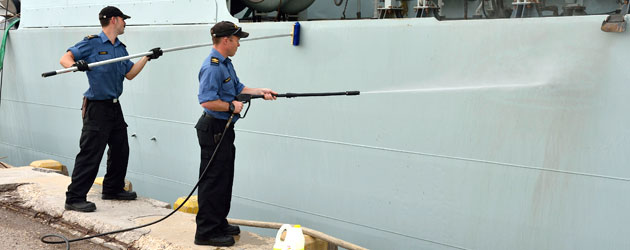
Leading Seaman Adam Flegel (left) and Master Seaman Craig Shillington wash HMCS Regina, while alongside in Kuwait City, Kuwait.
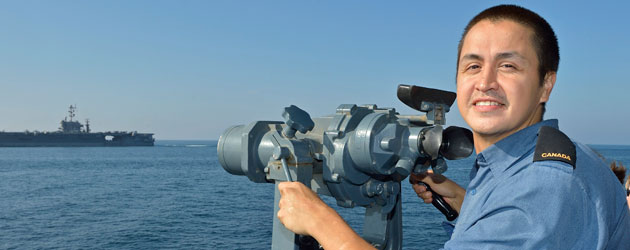
Ordinary Seaman Frank Grant observes USS John C Stennis from the starboard bridge wing of HMCS Regina during Operation Artemis.

Commanding Officer of HMCS Regina, Commander Jason Boyd, salutes HMS Diamond during Operation Artemis.
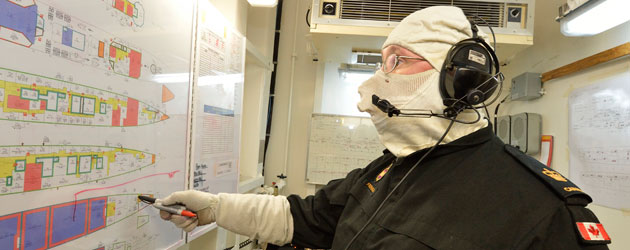
Petty Officer First Class Chris Ferguson, onboard HMCS Regina, writes on an incident board during a training exercise while deployed on Operation Artemis.

[caption id="attachment_2945" align="alignnone" width="300"] Airwoman E.F. Nightingale, served as a Canadian military photographer during the Second World War.[/caption] More than 70 years ago, during the height of the Second World War, Canadian military photographers were silent witnesses to a nation at war, all with the aim of capturing the moment on film, however grim.But many of the pictures of Canadian military personnel from the Second World War were staged for the media to use back home, shot by former press photographers who signed up to chronicle Canada’s involvement in the conflict.According to Collections Canada, late in 1939, Frank Badgley, commissioner of the Canadian Government Motion Picture Bureau, prepared a report recommending the Canadian Army organize a special film and photographic unit.The purposes of this unit, he wrote, would be:“… to record in motion pictures and photographs the day by day activities and achievements of…those units actively engaged in the combat zones, not only to provide an historical record, but to provide informational and inspirational material for…the maintenance of public morale and the stimulation of recruiting… [and]…to provide material for world wide distribution through the newsreels, news photo organizations, the press and other outlets… that will serve to keep Canada’s war efforts vividly before not only our own people but the rest of the world.”In 1940, a public relations photographic section was formed at Canadian Military Headquarters in London, England. It was the forerunner of the Canadian Army Film and Photo Unit set up in September 1941. Back in Canada, the photographic section of the Army’s Directorate of Public Relations was organized at Ottawa in 1942.In March 1940, Flying Officer Fergus Grant, the air press liaison officer of the Royal Canadian Air Force (RCAF), asked that the RCAF’s Photographic Establishment to create a “Press Photographic Section” for the purposes of “securing...

[caption id="attachment_2942" align="alignnone" width="300"] Anna Maria Alberts-Zeeman wrote a book called “The Peace Rose,” which is her memoirs about the Second World War in Amsterdam, including the liberation of Holland by Canadian soldiers.[/caption] Anna Maria Alberts-Zeeman has been a Canadian citizen for more than 50 years, but each spring she glances out her window in Sidney to see the Peace roses in bloom, and her thoughts turn to memories of Holland.These large vibrant pink and yellow roses take the 84-year-old Amsterdam native back to her teenage years – a time of fear, oppression and poverty in a war-torn country.Like many Dutch teenagers at the time, she spent her childhood in fear, wondering if her family would starve to death like so many compatriots had. Now in her twilight years, she decided to pen her memoirs. The Peace Rose is her book that chronicles her childhood in Holland, the liberation of Holland by Canadian soldiers, her immigration to Canada, and an inspirational journey through her life.Last year, she met with a group of soldiers from CFB Esquimalt about to attend the annual Nijmegen march in Holland.“I told those soldiers they reminded me of the young soldiers from so many years ago during the liberation, smiling and sharing chocolate bars with us. The Dutch will never forget what Canadians did for us. It is our life and our history. We cherish it,” she said. Amsterdam was one of the last places in Holland to be liberated after the war. Alberts-Zeeman was 12 when the war started and 17 when it ended. “I lost a big portion of my teenage years. By the last year it was just survival, as Holland was downhill already economically,” she said. “We lived in darkness when the war was on because we had to put black paper...

[caption id="attachment_2939" align="alignnone" width="300"] Leading Chef Brock West was rewarded with a trip to Canada after being honoured as New Zealand’s Sailor of the Year.[/caption] Recognition for a good deed has sent one New Zealand sailor to Canada. Leading Chef (LCH) Brock West of the Royal New Zealand Navy (RNZN) is in town to visit the Royal Canadian Navy on the Pacific Coast as part of his commendation.The 24-year-old was honoured this year as the RNZN’s Sailor of the Year for heroic actions he took when troubles arose during a salvage operation.LCH West and HNZS Rotoiti were aiding a salvage vessel with the break down of a grounded cargo ship when the seas got rough. “We were approaching in our little inflatable boat and we saw a man fall from the ladder,” says LCH West.The man fell five metres and landed on another person. It was then that the medically trained LCH West knew he had to do something.“Instinct took over, and I jumped from my boat to theirs,” he says. “The man who’d fallen was okay, but the one he’d landed on was a banged up. I administered first aid and we got them back to our ship.”Luckily both men came away with only bumps and a bruised vertebra.LCH West admits he was just doing what he thought was right, but the recognition still feels good.“If it was me I’d have wanted someone to do the same thing,” he says.While at CFB Esquimalt he toured the base museum, took in naval life on the West Coast, and had coffee with the RAdm Bill Truelove.“The Admiral is a great guy. We talked about the issues facing our two countries and the future of the navy,” he says. The actions he took are nothing short of what would be expected of...
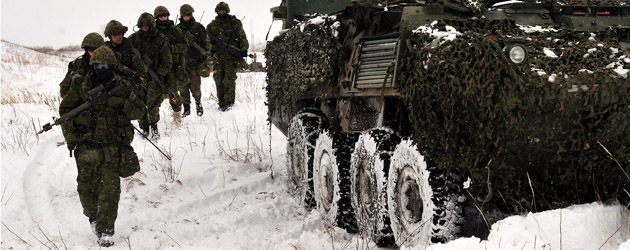
Canadian Forces soldiers from 5th Canadian Mechanized Brigade Group (5CMBG) participate in an attack scenario during Exercise Maple Resolve on October 24, 2012 in Wainwright, Alberta.
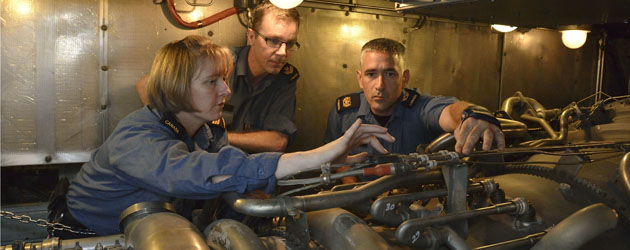
Petty Officer 2nd Class, Keri Vincent (left), Master Seaman Jeremiah Morley and Chief Petty Officer 2nd Class Kevin Sullivan (right) perform some maintenance on one of the engines onboard HMCS Regina while deployed on Operation ARTEMIS, in the Arabian Sea on November 03, 2012.

Master Corporal Paul Lacroix secures a SH-60 Seahawk helicopter from United States Ship (USS) John C Stennis onto the flight deck of HMCS Regina in the Arabian Sea during Operation ARTEMIS on November 15, 2012.
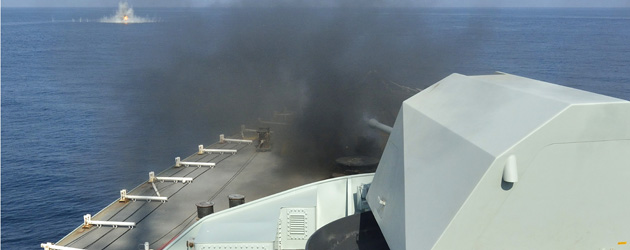
HMCS Regina fires her 57mm gun during a training exercise while in the Arabian Sea for Operation ARTEMIS on November 7, 2012.
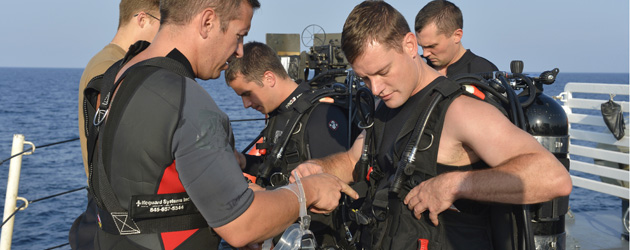
Ship's divers from HMCS Regina prepare to conduct a dive while deployed on Operation ARTEMIS in the Arabian Sea on November 1, 2012. Petty Officer Second Class Chris Johnson (left) assists Petty Officer First Class Kevin Jones.
The Navy Lighting Contest for 2012 at CFB Esquimalt has been postponed primarily due to extensive ongoing construction at Her Majesty’s Canadian (HMC) Dockyard. “I fully recognize the Navy Lighting event has become a tradition for many of us, including our neighbors in the community,” said Capt(N) Bob Auchterlonie, Base Commander of CFB Esquimalt. “My decision is based on a number of factors including the ongoing construction and renewal in HMC Dockyard, the ability for personnel to safely decorate buildings near the work being done, as well as the unavailability of ships due to operational and maintenance requirements.” Millions of dollars in construction work is being carried out in a variety of locations on the base. As well, a number of Pacific Fleet ships are either deployed or undergoing extensive maintenance work that precludes their availability to support the Navy Lighting Contest this year. The annual Navy Lighting Contest has been a unique holiday tradition for a number of years. Last year, nearly 5,800 visitors toured HMC Dockyard by bus via a pre-determined route, viewing the decorated ships and buildings, and voting for their favorite.
More than 190 women and men from HMCS Vancouver formed up in the Naden Drill Shed Nov. 16 to receive the Non-Article 5 NATO Medal for Service (Libya Medal). The drill shed was filled with nervous excitement as the sailors, soldiers and air personnel – formed up in three large platoons - awaited their turn to receive the medal. With the military band playing in the background, friends, family and distinguished guests watched as RAdm Bill Truelove, Commander of Maritime Forces Pacific and Joint Task Force Pacific; Cmdre Scott Bishop, Commander of Canadian Fleet Pacific; and Capt(N) Bob Auchterlonie, Base Commander of CFB Esquimalt; presented the medals. “In 20 years when I look back at my Libya Medal, I will feel a huge sense of pride” said LS Stephanie Masciotra, “We worked hard while we sailed in pitch darkness, and were always at the ready at everything we did.” The Libya Medal was awarded for Vancouver`s participation in Operation Mobile, the Canadian contribution to the NATO Operation Unified Protector. Vancouver was deployed to the Mediterranean region during Operation Mobile from July 10, 2011, to Feb. 19, 2012. “I’m so absolutely proud of every single one of them, of the things that they accomplished, not only for themselves but for the navy and Canada,” said Cdr Bradley Peats, Commanding Officer of Venture, and Vancouver’s Commanding Officer during Operation Mobile. Canada played a leading role in the UN-mandated operations with 630 CF members deployed to create a Libyan no-fly zone and prevent attacks on civilians by the government forces of Colonel Muammar Gaddafi. Other Canadian assets with Operation Mobile included CF-188 Hornet fighters, CC-150 Polaris in-flight refuelling tankers, CC-130 Hercules tankers, CP-140 Aurora long-range patrol aircraft as well as Canada’s massive C-177 Globemaster III aircraft. A/SLt MacDougall, BPAO Trainee

[caption id="attachment_2903" align="alignnone" width="300"] Leading Seaman, Graham Williams secures a hose from Royal Fleet Auxiliary (RFA) Wave Ruler, a British tanker, during a refueling at sea while deployed in the Arabian Sea for Operation ARTEMIS on November 16, 2012.[/caption] As you’re driving down the road, across town or even across the country, do you wonder when you will next get a chance to buy gas, and maybe a snack? Count yourself lucky you’re in a car. If you were driving a warship, you would face that problem on a much grander scale. Ships that have to stay at sea for extended periods must find a way to restock everything ship and crew consume — from peanut butter to engine parts to fuel. It’s called “replenishment at sea” — abbreviated RAS (pronounced “razz”) — and the commodity most often replenished this way is fuel. When a ship such as HMCS Regina refuels at sea, the crew aligns it beside a replenishment ship (called a tanker). As the two ships keep station, cruising along side by side, the two crews rig a span wire to connect them.Then the tanker crew uses the span wire to send a fuel hose fitted with the right kind of nozzle to the receiving ship. The crew of the receiving ship catch the nozzle of the fuel hose and attach it to their inlet pipe. When everything is firmly connected, the fuel starts to flow. Imagine trying to fill up your car from a tanker truck while both you and the truck driver keep going down the highway, side by side. Since leaving Esquimalt July 3, 2012, Regina has replenished at sea more than a dozen times, taking fuel from American and British naval tankers. From initial planning to completion, each RAS requires a high degree of...

On November 11th, more than eighty members of the Royal Canadian Navy participated in the parade on Saltspring Island.